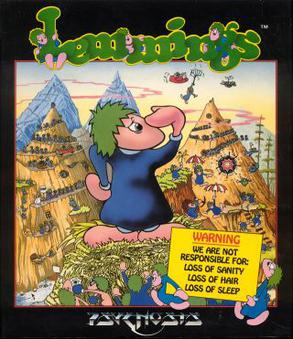
Lemmings is a puzzle–strategy video game originally developed by DMA Design and published by Psygnosis for the Amiga in 1991 and later ported for numerous other platforms. The game was programmed by Russell Kay, Mike Dailly and David Jones, and was inspired by a simple animation that Dailly created while experimenting with Deluxe Paint.
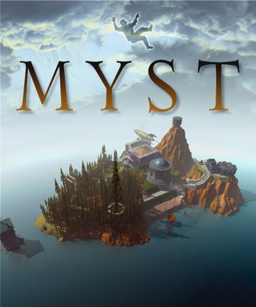
Myst is an adventure video game designed by Rand and Robyn Miller. It was developed by Cyan, Inc., published by Broderbund, and first released in 1993 for the Macintosh. In the game, the player travels via a special book to a mysterious island called Myst. The player interacts with objects and traverses the environment by clicking on pre-rendered imagery. Solving puzzles allows the player to travel to other worlds ("Ages"), which reveal the backstory of the game's characters and help the player make the choice of whom to aid.

The Blaster Learning System is an educational video game series created by Davidson & Associates and later published by JumpStart after the two companies were acquired and merged by CUC Software. The games primarily focused on mathematics, later expanding into language arts and science, and spawned an animated children’s television series in 1999 called Blaster's Universe.

The 7th Guest is an interactive movie puzzle adventure game, produced by Trilobyte and originally released by Virgin Interactive Entertainment in April 1993. It is one of the first computer video games to be released only on CD-ROM. The 7th Guest is a horror story told from the unfolding perspective of the player, as an amnesiac. The game received press attention for making live action video clips a core part of its gameplay, for its then-unprecedented amount of pre-rendered 3D graphics, and for its adult content. The game was very successful, with over two million copies sold. The game alongside Myst, is widely regarded as a killer app that accelerated the sales of CD-ROM drives. The 7th Guest has subsequently been re-released on Apple's app store for various systems such as the Mac. Bill Gates called The 7th Guest "the new standard in interactive entertainment".

Space Ace is a LaserDisc video game produced by Bluth Group, Cinematronics and Advanced Microcomputer Systems. It was unveiled in October 1983, just four months after the Dragon's Lair game, followed by a limited release in December 1983 and then a wide release in Spring 1984. Like its predecessor, it featured film-quality animation played back from a LaserDisc.

King's Quest V: Absence Makes the Heart Go Yonder! is a 1990 graphic adventure game by Sierra On-Line. Originally released in November 1990, it featured a significant improvement in graphics. It was also the first King's Quest installment to replace the typing user interface with a point-and-click user interface. The title is a spoof on the proverb "Absence makes the heart grow fonder".

King's Quest VI: Heir Today, Gone Tomorrow is a point-and-click adventure game, first released in 1992 as the sixth installment in the King's Quest series produced by Sierra On-Line. Written by Roberta Williams and Jane Jensen, King's Quest VI is widely recognized as the high point in the series for its landmark 3D graphic introduction movie and professional voice acting. King's Quest VI was programmed in Sierra's Creative Interpreter and was the last King's Quest game to be released on floppy disk. A CD-ROM version of the game was released in 1993, including more character voices, a slightly different opening movie and more detailed artwork and animation.
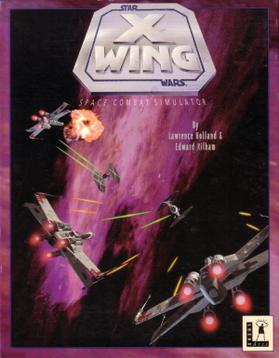
Star Wars: X-Wing is a space simulation video game, the first of the X-Wing combat flight simulation games series. The player's character flies starfighters, including the X-wing, for the Rebel Alliance. The narrative precedes and parallels the events of Star Wars Episode IV: A New Hope.

Toonstruck is a graphic adventure video game developed by Burst Studios, published by Virgin Interactive Entertainment and released in 1996 for DOS. The game features hand-drawn imagery and animated characters, but the protagonist Drew Blanc is represented as a video-captured live action character interacting with the cartoon world around him. In the game, Blanc is transported into the cartoon world he created while suffering from a creative block. Blanc is accompanied by his animated sidekick Flux Wildly.
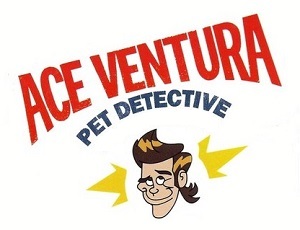
Ace Ventura: Pet Detective is an animated television series based on the film of the same name. The series was produced by Morgan Creek Productions, Funbag Animation Studios, Nelvana Limited, for the first two seasons and Odyssey Entertainment for the third and final season. It aired for two seasons from 1995 to 1997 on CBS. A third season and reruns of previous episodes aired on Nickelodeon from 1999 to 2000.

Space Quest IV: Roger Wilco and the Time Rippers is a 1991 graphic adventure game by Sierra On-Line, and the fourth entry in the Space Quest series. The game was released originally on floppy disks in March 1991, and later released on CD-ROM in December 1992 with full speech support; an Atari ST version was announced via Sierra Online's magazine, Sierra News Magazine, but was later canceled. The game sees players assume the role of Roger Wilco, who is thrust into a new adventure across time and space where he must thwart the plans of an old foe that is seeking revenge against him.
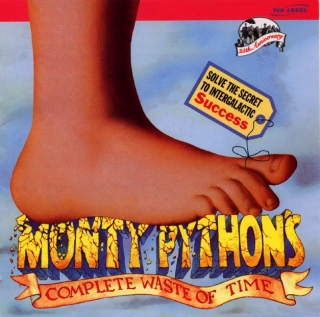
Monty Python's Complete Waste of Time is a collection of minigames, screensavers, desktop wallpaper and icons for Mac OS System 7 and Windows released in 1994 by 7th Level, Inc. It was brought on board the Mir Space Station by astronaut Andy Thomas.
In the 1990s, Philips Interactive Media published three action-adventure games based on Nintendo's Legend of Zelda franchise for its Compact Disc-Interactive (CD-i) players. The first two, Link: The Faces of Evil and Zelda: The Wand of Gamelon, were developed by Animation Magic and released simultaneously on October 10, 1993, and Zelda's Adventure was developed by Viridis and released on May 10, 1996. The two latter entries are the first to feature Princess Zelda as the protagonist instead of Link. Faces of Evil and Wand of Gamelon use the side-scrolling view introduced in Zelda II: The Adventure of Link (1987), while Zelda's Adventure has a top-down view reminiscent of the original 1986 game. All three are non-canon to the Zelda franchise.
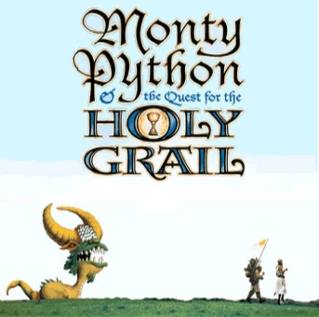
Monty Python & the Quest for the Holy Grail is an adventure game created by 7th Level in 1996 for Windows. The game is based on the 1975 film Monty Python and the Holy Grail and was the second of three Monty Python games created by 7th Level.

Uncle Henry's Playhouse is the third game in The 7th Guest series. Functionally the game is a compilation game mostly composed of the puzzles from Trilobyte's games The 7th Guest, The 11th Hour, and Clandestiny, but featuring little plot. The game has been noted for its low sales figures and its rarity/obscurity relative to its blockbuster predecessors, The 7th Guest and The 11th Hour. The game is primarily intended as a means of presenting puzzles from the previous titles in the 7th Guest series and consequently it has a rather simplistic plot that has been criticized by reviewers for its thinness in comparison to the previous games. The game also includes previews for two then-upcoming Trilobyte games, Tender Loving Care and Dog Eat Dog.
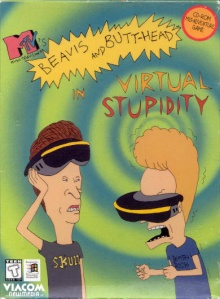
Beavis and Butt-Head in Virtual Stupidity is a point-and-click adventure computer game based on the American animated television series created by Mike Judge, Beavis and Butt-Head, that was developed by ICOM Simulations and published by Viacom New Media.

The Ace Ventura franchise, originally created by Jack Bernstein, consists of American detective-comedies, with two theatrical films, one made-for-television film, and one animated television series. The overall story follows the criminal investigations of the titular and comedic pet detective.

Disney's Animated Storybook is a point-and-click adventure interactive storybook video game series based on Walt Disney feature animations and Pixar films that were released throughout the 1990s. They were published by Disney Interactive for personal computers for children ages four to eight years old. Starting from 1994, most of the entries in the series were developed by Media Station. They have the same plots as their respective films, though abridged due to the limited medium.

The Hunchback of Notre Dame: Topsy Turvy Games is a game that was released in 1996 by Disney Interactive for Microsoft Windows and Game Boy. It was the second title in the company's GameBreak! series after GameBreak! Timon and Pumbaa's Jungle Games. Tiertex adapted the game for SNES, Game Boy, and Super Game Boy, which were published by THQ.

Reah: Face the Unknown, known in North America as simply Reah, is a 1998 first-person puzzle-oriented adventure game with a non-linear plot, described as a Myst-clone. It was developed by Project Two Interactive / Black Friar and published by Detalion and LK Avalon. It was distributed by Erbe in Spain on October 10, 1998. It was published by Project 2 Interactive in the Netherlands, and distributed in the U.S. and Canada by GT Interactive in 1999.



















